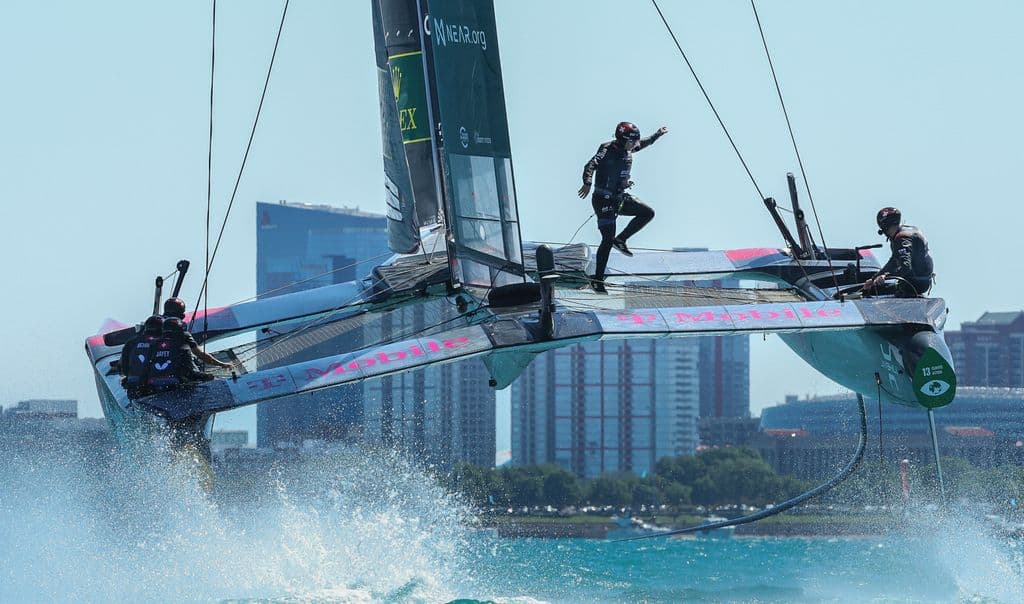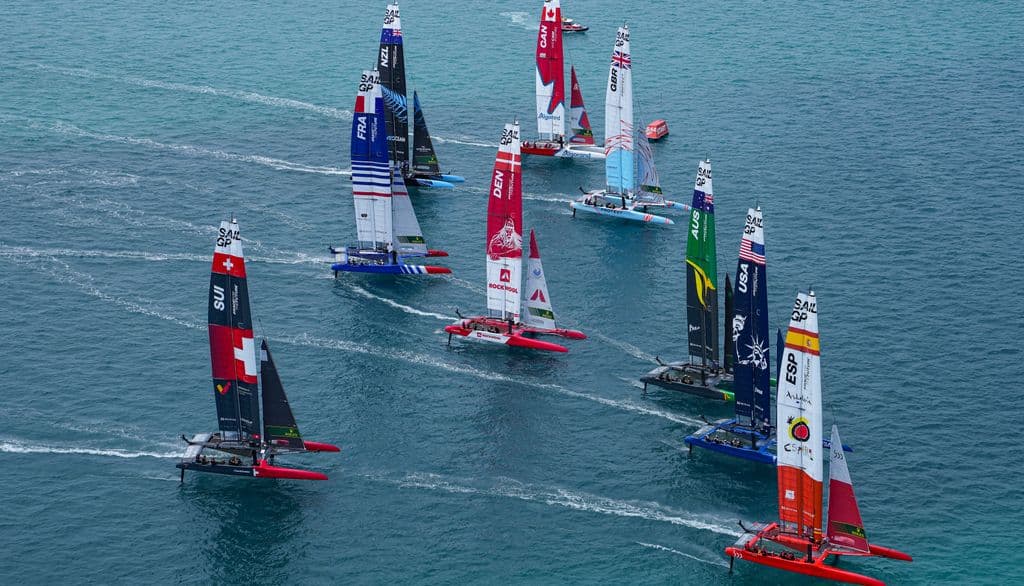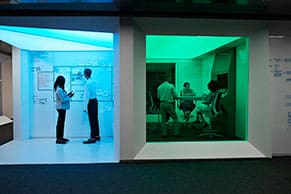In 2018, SailGP launched with a modest ambition: redefine professional sailing through a new global racing league. The boats would be faster. Events would be held throughout the year. And, perhaps most importantly, the league would be fan-centric – in direct contrast to the arguably closed-off and infrequent sailing events of the past.
In its inaugural season, SailGP had six international teams competing in five events in some of the world’s most iconic harbors. Each event featured equally matched, hydrofoiling catamarans capable of speeds up to 60 mph. Using Oracle Cloud Infrastructure (OCI), the SailGP team processed 240,000 data points every second from thousands of sensors attached to the catamarans. This meant that, in addition to watching video coverage, spectators could engage with real-time race metrics.
Fans responded enthusiastically to the thrilling new sport, with SailGP’s Season 2 Championship garnering a total audience of nearly 830 million. Now in Season 3, the global racing league boasts nine teams competing in 11 grand prix events – with plans to increase both numbers in coming seasons.
As SailGP grew and its world-class athletes got to grips with the high-speed hydrofoiling F50s, the task of juggling a growing roster of subsidiaries around the world became more challenging.
SailGP’s leadership set an ambitious growth trajectory:
- 2018: 6 teams and 5 events
- 2019: 8 teams and 8 events
- 2022: 9 teams and 11 events
- 2025: 16 teams and 20+ events
Growing from one stage to the next has involved taking on a minority stakeholder to co-own the league, creating new subsidiaries around the world and analyzing costs for increasingly more potential events. Julie Boyd, SailGP’s director of finance, was tasked with finding ways to handle these initiatives with minimal additions to finance headcount.
Her team’s tactics included:
- Accelerating the reporting process with entry automation
- Automating the financial management and consolidation of subsidiaries
- Amping up scenario analysis capabilities
- Customizing the purchase order approval process to better conserve and direct cash flow
Eliminating Manual Processes for Speedier Reporting
The first issue Boyd’s team faced: Outdated, manual processes hindered SailGP’s reporting. SailGP accrues any purchase to which it has already committed, which meant the team previously had to manually input each purchase order into a journal entry. Employees would also manually create purchase orders for each individual contractor at SailGP’s labor-intensive events.
While leadership wanted employees to focus on more strategic tasks, they faced the reality that employees were too bogged down with data entry to take anything else on. With the fast-paced nature of the organization, hiring more to handle the workload wasn’t an option, driving the team to automate instead with NetSuite OneWorld.
With manual tasks eliminated, Boyd’s team saves time in multiple areas.
For instance, “Now we just run those purchase orders that come in a spreadsheet and upload it to the journal,” she said. “Every reporting period, that [saves] a junior person a couple of days of work.”
And while it used to take a few days to create individual purchase orders for hundreds of event contractors, “now, we can just upload a spreadsheet and all the POs are done, which has cut days off our reporting.”
When SailGP took on an investor with a percentage ownership in the league, its reporting needed to be even faster. The business needed to operate on a standard calendar year with a rough estimate of performance for the year by January 31. For regulatory requirements, final financial statements would need to be signed, dotted and audited by May 31.
“I thought, ‘There's no possible way that I can get this done in time,’” said Boyd. But “using all of the functionality [of NetSuite], we're now able to get really good reporting out no more than 10 days after the month- or quarter-end, which helps us make decisions really quickly. It used to be a real push, because we'd have to do so much of the work manually, but so much of it is automated now.”

Navigating the Complexity of a Global Business
On a broader scale, SailGP’s very structure introduced complexity into its operations. Every time it introduced a new sailing team, event or boat-building facility, it had to create a subsidiary. The resulting list of business entities was not only long but also varied in function, invoking a litany of global reporting requirements.
SailGP simplified subsidiary management by using NetSuite OneWorld’s country-specific configurations for each of its 11 current subsidiaries, ensuring compliance with local accounting, tax and regulatory requirements. The team also eased administrative tasks and got an accurate pulse on the business as a whole by tapping into NetSuite’s ability to handle numerous currencies and languages, as well as its multi-book accounting capabilities.
“I would tell anyone that wants to run a multi-country and multifaceted type of business that NetSuite is the way to go,” said Boyd. “I don't know how we would do this with all of these subsidiaries if we didn't have NetSuite and we couldn't consolidate them together.”
The global insights SailGP gets from OneWorld become particularly integral when the business considers adding new events and teams to its roster. With plans to expand its number of teams and events, SailGP is conducting scenarios to determine whether it’s more cost-effective to run events in the same locations as it has before or in new venues. It uses NetSuite’s repository of data to access granular insights into past costs – like shipping, catering, and travel – by event location, then model out what costs may look like in the future.
“NetSuite has allowed [SailGP’s finance team] to add more value and credibility,” said Boyd. “When we first started, we would have to give approximate answers. Now, if someone asks me a question about how much an event or a team costs, I can give them the answer and they know that I can back it up.”

Creating a Unique Solution for a Unique Business
With an ever-growing list of subsidiaries with widely differing functions, SailGP knew its needs weren’t the ones of a “typical” business. As it continued its journey with NetSuite, a question surfaced: Could it customize the solution even more?
Boyd and her team began meeting with NetSuite Advanced Customer Support (ACS) with a list of projects that they wanted to explore.
“By the end of [our first meeting with the ACS team], I realized there were so many things I didn’t know about our NetSuite system,” said Boyd. “There were so many things that NetSuite could do for us that we weren’t doing.”
Since then, SailGP has worked with the NetSuite ACS team to create and implement numerous customizations. Major ones include a more intricate process for sorting and approving purchase orders to support cash flow: Instead of only getting approval from a cost center manager, POs now must also get approval from a budget manager to ensure they’re being posted correctly. This customization saves Boyd hours when running reports.
“Now we've got this system right down to exactly what we want it to do for us,” said Boyd. “And it's continuous improvement. Whenever we have a change, we're able to work with ACS to integrate it into NetSuite and figure out how it could work best for us.”
Ready to Expand Its Technological Footprint
SailGP isn’t about to rest on its laurels as the world’s fastest-growing sailing race, though. This year, the company announced the launch of its technology division, SailGP Technologies. This commercial endeavor brings SailGP’s expertise to the forefront, monetizing its leading-edge capabilities in design, manufacturing, engineering, software and systems across land, sea, and space.
As SailGP evolves its offerings, it’s bringing NetSuite along as a valued partner, implementing NetSuite Customer Relationship Management (CRM) and Advanced Inventory Management (opens in new tab).
“If we do things right, over time, SailGP Technologies should be way bigger than the SailGP racing company – this will be the future,” said Boyd. “We're building parts for rockets that go to the moon right now. So we're definitely expanding beyond building and racing sailboats.”
Does your business involve international subsidiaries? See how you can save time whenaccounting in multiple currencies with NetSuite (opens in new tab).




